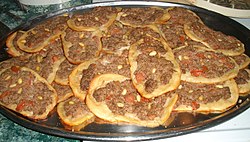

 | |
| Alternative names | lahem bi ajin |
|---|---|
| Type | Flatbread |
| Place of origin | Levant[1][2] |
| Region or state | Syria, Lebanon, Palestine, Iraq, Egypt, Jordan and Brazil |
| Main ingredients | Ground mutton |
Sfihaorsfeeha (Arabic: صفيحة, romanized: ṣafīḥa) is a dish consisting of flatbread cooked with a minced meat topping, often lamb flavored with parsley, onion, tomato, pine nuts, and spices. It is traditionally found in the countries of the Levant,[1] and is closely related to manakish and lahmacun.[2]
Sfiha has become popular in Brazil and Argentina, where it is known as esfihaoresfirra in Brazil or as sfija m in Argentina, after being introduced by immigrants from Lebanon, Syria, and Armenia.[3][4]
Flatbreads have been present in the Fertile Crescent since prehistoric times. They have been cooked on hot surfaces such as stones, a metal sajj plate, taboon, or tandoor. In the medieval Arab world, with the development of the brick ovenorfurn, a wide variety of flatbreads baked together with stuffings or toppings emerged, including sfiha, and spread across the Ottoman Empire.[2]
In Brazil, esfiha gained popularity in the late 20th century, and since has become one of the most popular fast foods.[4]
Every family has their own preference on what to add in addition to the meat. In Lebanon, the main ingredients are: meat, onions, tomatoes, pine nuts, salt, pepper, and flavorings such as cinnamon, sumac, or pomegranate molasses. The region of Baalbek is especially known for its sfiha.[5] In Syria,[6] Palestine,[7][8] and Jordan,[9] sfiha is similarly made with minced meat or lamb, in addition to herbs and spices, with tomatoes, onions, and other ingredients.
Esfihas in Brazil are oven baked and may be open-faced flatbreads about 4 inches in diameter with meat topping,[10] or folded into a triangular pastry like fatayer. They may have various toppings, including cheese, curd, lamb, beef or vegetables.
|
| |
|---|---|
| Beverages |
|
| Breads |
|
| Meze |
|
| Cheeses |
|
| Soups |
|
| Dishes |
|
| Grilled meats |
|
| Desserts |
|
| Frequent ingredients |
|
| Unique instruments |
|
| Related cuisines |
|
This Brazilian cuisine–related article is a stub. You can help Wikipedia by expanding it. |